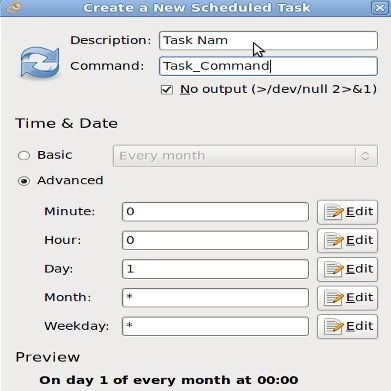Most Linux/Unix veterans use cron to schedule tasks on their machines and it is a very powerful utility for what it does.
The problem with cron is that it's way to hard and cryptic to use for the newbies / average Linux user. For them, there is an easier alternative to get things done.
Gnome-schedule is a graphical front-end to cron and at, another utility to execute commands at a specified time. It is completely GUI driven and the user does not need to have any prior knowledge of cron or it’s syntax.
To install it in Ubuntu / Debian, all you have to do is open a terminal and type:

When creating a new task, you can enter numeric values for: minute, hour, day, month or weekday. If you want it to run on all (minutes, hours, days, month or weekdays), simply enter an: "*". For better understanding, look at the example below:

The above task will be run on Day 1 of every month at 0 hours and 0 minutes.
You don’t even need to manually enter the times. Click on the Edit button next to the text field and you will be able to select the exact time of the task using a simple GUI:

Once a task has been created, the gnome-schedule application can be closed and cron will take care of executing the task at your chosen time and interval.
The problem with cron is that it's way to hard and cryptic to use for the newbies / average Linux user. For them, there is an easier alternative to get things done.
Gnome-schedule is a graphical front-end to cron and at, another utility to execute commands at a specified time. It is completely GUI driven and the user does not need to have any prior knowledge of cron or it’s syntax.
To install it in Ubuntu / Debian, all you have to do is open a terminal and type:
sudo apt-get install gnome-schedule
When creating a new task, you can enter numeric values for: minute, hour, day, month or weekday. If you want it to run on all (minutes, hours, days, month or weekdays), simply enter an: "*". For better understanding, look at the example below:

The above task will be run on Day 1 of every month at 0 hours and 0 minutes.
You don’t even need to manually enter the times. Click on the Edit button next to the text field and you will be able to select the exact time of the task using a simple GUI:

Once a task has been created, the gnome-schedule application can be closed and cron will take care of executing the task at your chosen time and interval.

